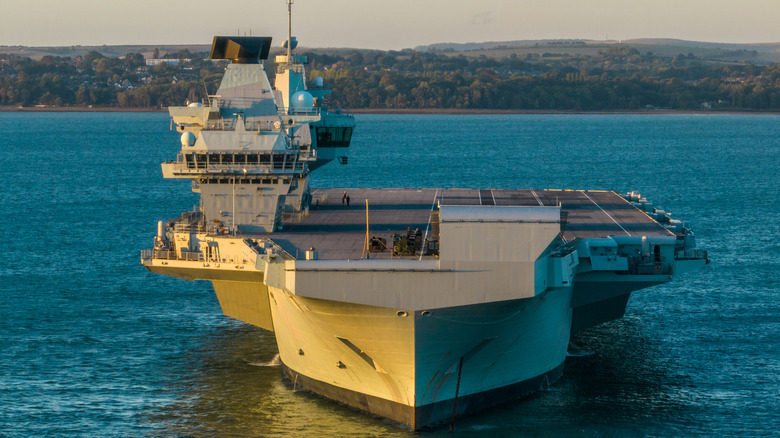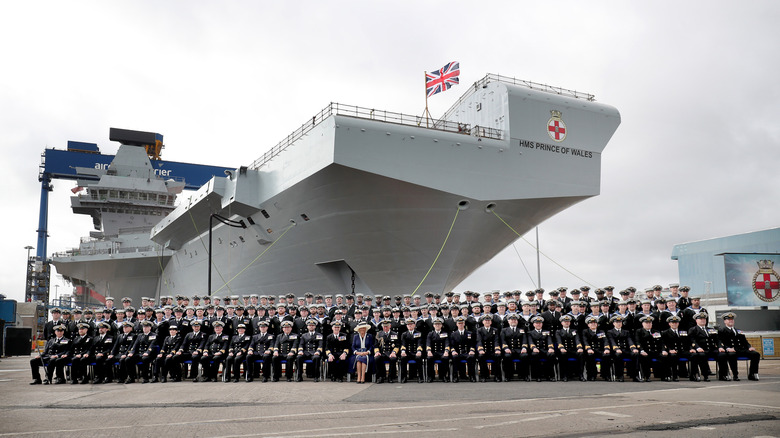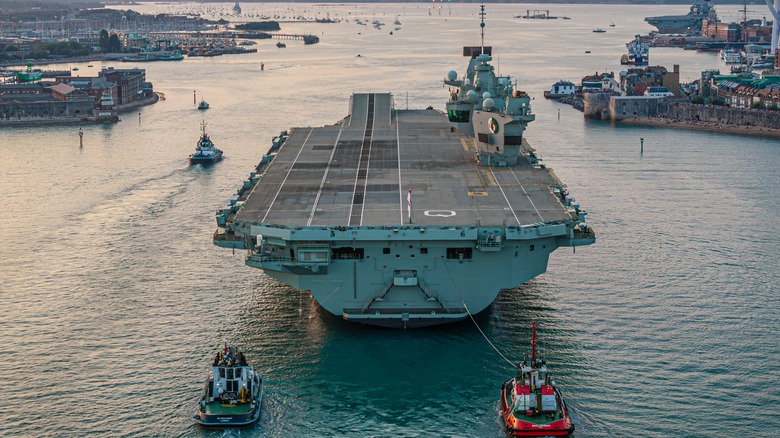Why Aren't British Aircraft Carriers Nuclear Powered?
British aircraft carriers are an awesome sight. The HMS Prince of Wales, the Royal Navy's flagship since late 2024, is one of the iconic Queen Elizabeth class of carriers. It has a 280-meter-long flight deck and displaces around 65,000 tonnes, accommodating approximately 1,600 crew. It's not as large as the USS Gerald R. Ford, the biggest aircraft carrier in the world, but it is extraordinary, nonetheless.
There's a particular difference between the HMS Prince of Wales and the USS Gerald R. Ford: The latter is powered by a pair of nuclear reactors, while the British carrier is not. No British models are, in fact. There's no denying that there are advantages to nuclear reactors powering naval vessels, but other means of propulsion aren't strictly a weakness either. British carriers are, instead, electrically powered. Prospect Magazine reports that each Queen Elizabeth carrier can "generate enough power to light a large town," and that there are significant safety and maintenance concerns connected to an aircraft's nuclear reactors that the British crews don't need to concern themselves with.
In designing aircraft carriers, the propulsion system is a chief concern because each type of propulsion has its strengths and weaknesses. The choice is about prioritizing what is deemed best for a country's specific needs and situation. Nuclear reactors may improve a carrier's ability to stay at sea longer, but there are some considerable downsides that may have contributed to making nuclear less appropriate for British models than U.S. ones. Prohibitive costs for the nuclear option and the Royal Navy's specific situation are key among them.
The cost of nuclear-powered aircraft carriers can be prohibitive
Nuclear reactors are excellent sources of power for vessels on long missions. Naturally, this is a huge boon for submarines, which may be required to stay submerged for a long time. In such a scenario, it would cause significant disruption to conventionally refuel, but that isn't an issue here. A carefully maintained nuclear reactor does not require frequent refueling, and it's for this reason that the technology was so prominently adopted by submarines. The British Royal Navy boasts nine submarines as of January 2025, with the most prominent among them being the quintet of vessels in the Astute class. They are nuclear-powered and capable of generating oxygen and drinkable water for the crew, too, meaning that their operations underwater can last even longer.
Nonetheless, when it comes to aircraft carriers, the British naval leadership wasn't sold on the option. Commodore Jerry Kyd, commander of the HMS Queen Elizabeth, is quoted by Wired as stating that making the ship nuclear-powered was a possibility that "was quickly assessed and quickly put out of the options, because it's not worth the money." The benefits weren't sufficient to make up for the higher costs.
Aircraft carriers aren't the speediest ships around, but the vessel can attain the speed it needs to without it, he said, adding, "When you look at through-life costings as a country, we couldn't afford it even if we wanted it." According to the UK Defense Journal, a nuclear reactor can make a ship cost almost three times as much over the course of its operational life, which certainly helps to explain the reluctance.
The advantages of conventional aircraft carriers
The HMS Prince of Wales has two gas turbines and four diesel generators, and managing them requires the care and attention of approximately 170 crew members. Using this system, it's possible to avoid some of the issues associated with nuclear-powered systems that are costly and difficult to maintain and require specialized staff members, something that isn't necessary on the British vessels. The Ministry of Defense wanted to ensure the crew could be minimized, and this is far easier on a vessel without a nuclear reactor. Decommissioning them is also an expensive business.
While the long interval between major refueling is beneficial for nuclear models, it does simultaneously provide a significant hurdle. It can be more practical to simply refuel on the go. With nuclear-powered carriers, the vessel itself doesn't require refueling, but the many aircraft that may call it home at any one time will. This lessens the burden of refueling the carrier itself, as other assets on board require the resources to do so anyway.
The range advantage nuclear power provides is also lessened by the fact that a global network of safe ports can allow vessels to venture further afield without requiring it. For some nations, this is more of a concern than others. It is also not necessarily the case that non-nuclear aircraft carriers are unusual. In terms of the number of vessels alone, China has the world's largest navy, but none of its three aircraft carriers are nuclear-powered. The fourth, which is currently in construction, may be, Popular Mechanics notes. Nuclear aircraft carriers do have considerable advantages over diesel models, but they are not always the best fit.


